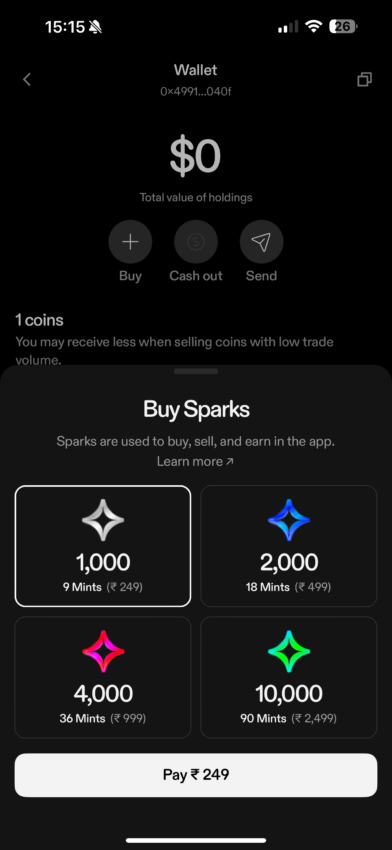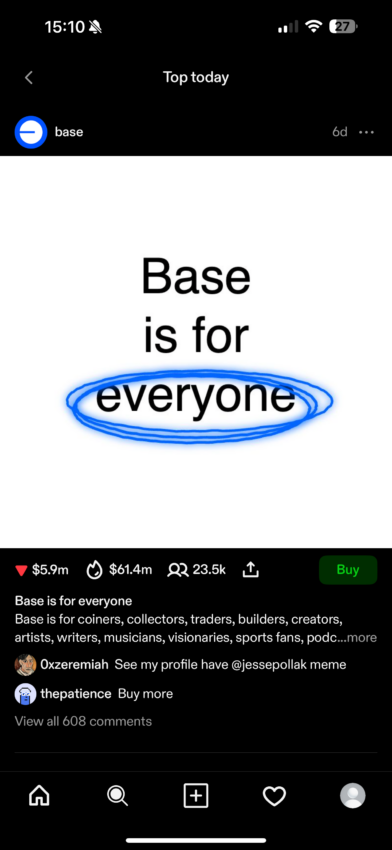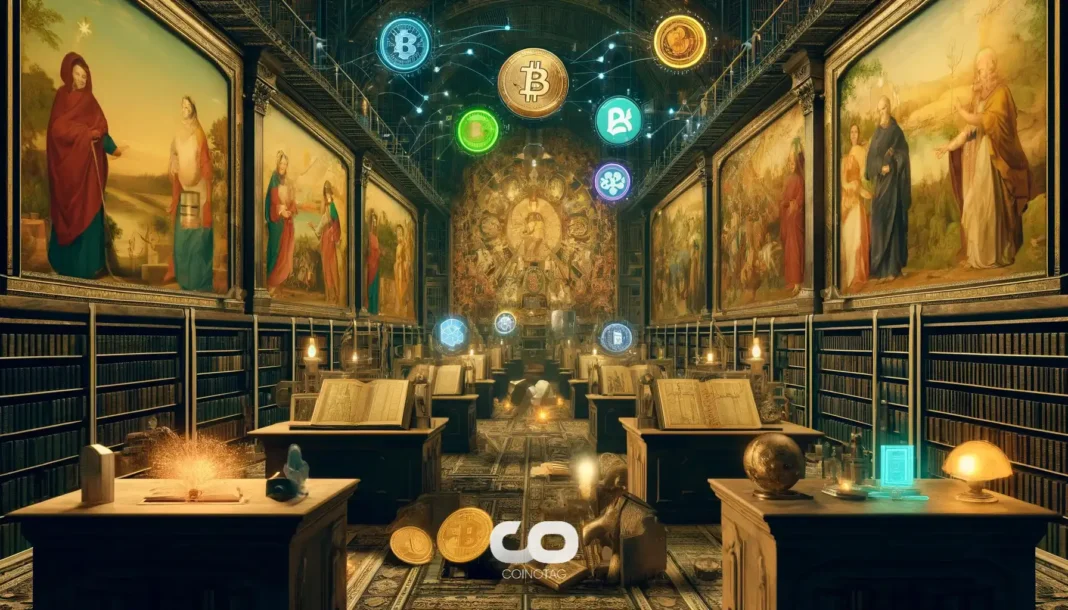| COINOTAG recommends • Exchange signup |
| 💹 Trade with pro tools |
| Fast execution, robust charts, clean risk controls. |
| 👉 Open account → |
| COINOTAG recommends • Exchange signup |
| 🚀 Smooth orders, clear control |
| Advanced order types and market depth in one view. |
| 👉 Create account → |
| COINOTAG recommends • Exchange signup |
| 📈 Clarity in volatile markets |
| Plan entries & exits, manage positions with discipline. |
| 👉 Sign up → |
| COINOTAG recommends • Exchange signup |
| ⚡ Speed, depth, reliability |
| Execute confidently when timing matters. |
| 👉 Open account → |
| COINOTAG recommends • Exchange signup |
| 🧭 A focused workflow for traders |
| Alerts, watchlists, and a repeatable process. |
| 👉 Get started → |
| COINOTAG recommends • Exchange signup |
| ✅ Data‑driven decisions |
| Focus on process—not noise. |
| 👉 Sign up → |
-
As the cryptocurrency landscape evolves, innovative concepts like content coins emerge, intertwining digital tokens with social media posts and memes.
-
Content coins represent a unique fusion of social interaction and blockchain technology, aiming to redefine creator monetization and asset speculation.
-
Jesse Pollak, head of Coinbase’s Base network, states, “Base is for everyone,” highlighting how this new format is reshaping the crypto landscape.
This article explores the rise of content coins, analyzing their implications for crypto markets, creator monetization, and community engagement.
Understanding Content Coins: A New Frontier in Cryptocurrency
A content coin is a unique crypto token associated with a specific piece of digital content, such as a tweet or video. Unlike traditional tokens that represent ownership of a brand or service, content coins encapsulate individual moments, lending the ability for users to trade shares based on the content’s popularity and virality.
This trend has exploded recently due to the ease of minting tokens, allowing anyone to create a tradable asset tied to their digital expressions. Platforms such as Zora facilitate this process, enabling the seamless transformation of social interactions into financial instruments.
How Zora Powers the Content Coin Ecosystem
Central to the rise of content coins is Zora, a protocol that allows creators to tokenize their content efficiently. Zora is frequently recognized alongside platforms like PomPom and Farcaster but stands out for its focus on monetizing media. The integration with Coinbase’s OP Stack allows tokens minted on Zora to leverage the speed and cost-efficiency of the Base network.
| COINOTAG recommends • Professional traders group |
| 💎 Join a professional trading community |
| Work with senior traders, research‑backed setups, and risk‑first frameworks. |
| 👉 Join the group → |
| COINOTAG recommends • Professional traders group |
| 📊 Transparent performance, real process |
| Spot strategies with documented months of triple‑digit runs during strong trends; futures plans use defined R:R and sizing. |
| 👉 Get access → |
| COINOTAG recommends • Professional traders group |
| 🧭 Research → Plan → Execute |
| Daily levels, watchlists, and post‑trade reviews to build consistency. |
| 👉 Join now → |
| COINOTAG recommends • Professional traders group |
| 🛡️ Risk comes first |
| Sizing methods, invalidation rules, and R‑multiples baked into every plan. |
| 👉 Start today → |
| COINOTAG recommends • Professional traders group |
| 🧠 Learn the “why” behind each trade |
| Live breakdowns, playbooks, and framework‑first education. |
| 👉 Join the group → |
| COINOTAG recommends • Professional traders group |
| 🚀 Insider • APEX • INNER CIRCLE |
| Choose the depth you need—tools, coaching, and member rooms. |
| 👉 Explore tiers → |

This accessibility and low-cost structure of minting coins is a key factor behind their rapid adoption, drawing a diverse range of participants, including artists, influencers, and content creators, each eager to explore the potential of financial returns from their digital creations.
| COINOTAG recommends • Exchange signup |
| 📈 Clear interface, precise orders |
| Sharp entries & exits with actionable alerts. |
| 👉 Create free account → |
| COINOTAG recommends • Exchange signup |
| 🧠 Smarter tools. Better decisions. |
| Depth analytics and risk features in one view. |
| 👉 Sign up → |
| COINOTAG recommends • Exchange signup |
| 🎯 Take control of entries & exits |
| Set alerts, define stops, execute consistently. |
| 👉 Open account → |
| COINOTAG recommends • Exchange signup |
| 🛠️ From idea to execution |
| Turn setups into plans with practical order types. |
| 👉 Join now → |
| COINOTAG recommends • Exchange signup |
| 📋 Trade your plan |
| Watchlists and routing that support focus. |
| 👉 Get started → |
| COINOTAG recommends • Exchange signup |
| 📊 Precision without the noise |
| Data‑first workflows for active traders. |
| 👉 Sign up → |
The Mechanism of Content Coins
The process of creating a content coin begins when a piece of content is selected for tokenization. This content is then minted into a coin and can be traded like any other cryptocurrency. Each content coin harnesses the market’s ability to determine its value based on audience engagement and reception.
A content coin can be viewed as an investment in not just the content but also the time and creativity of the creator. As one participant on social media aptly noted, each coin reflects how much an audience is willing to reward creators for their contributions.
| COINOTAG recommends • Traders club |
| ⚡ Futures with discipline |
| Defined R:R, pre‑set invalidation, execution checklists. |
| 👉 Join the club → |
| COINOTAG recommends • Traders club |
| 🎯 Spot strategies that compound |
| Momentum & accumulation frameworks managed with clear risk. |
| 👉 Get access → |
| COINOTAG recommends • Traders club |
| 🏛️ APEX tier for serious traders |
| Deep dives, analyst Q&A, and accountability sprints. |
| 👉 Explore APEX → |
| COINOTAG recommends • Traders club |
| 📈 Real‑time market structure |
| Key levels, liquidity zones, and actionable context. |
| 👉 Join now → |
| COINOTAG recommends • Traders club |
| 🔔 Smart alerts, not noise |
| Context‑rich notifications tied to plans and risk—never hype. |
| 👉 Get access → |
| COINOTAG recommends • Traders club |
| 🤝 Peer review & coaching |
| Hands‑on feedback that sharpens execution and risk control. |
| 👉 Join the club → |

The Rise of Base: Facilitating Content Coin Growth
The majority of content coin activity is occurring on the Base network. This environment offers a compelling combination of low transaction fees and rapid processing times, making it an ideal setting for the trading of high-velocity tokens.
Beyond technical advantages, Jesse Pollak’s visionary outlook positions Base as a cultural platform for crypto exchanges, allowing creators to view their work in an entirely different light. His framing of content coins as a cultural innovation reflects why the ecosystem is thriving on Base.
Distinguishing Content Coins from Meme Coins and NFTs
While some might argue that content coins mimic the characteristics of meme coins, key differences set them apart. Meme coins typically embody a broader concept or community sentiment, often detached from a specific moment or post. In contrast, a content coin originates from a single identifiable piece of content, allowing for a unique connection between the asset and its creator.
| COINOTAG recommends • Exchange signup |
| 📈 Clear control for futures |
| Sizing, stops, and scenario planning tools. |
| 👉 Open futures account → |
| COINOTAG recommends • Exchange signup |
| 🧩 Structure your futures trades |
| Define entries & exits with advanced orders. |
| 👉 Sign up → |
| COINOTAG recommends • Exchange signup |
| 🛡️ Control volatility |
| Automate alerts and manage positions with discipline. |
| 👉 Get started → |
| COINOTAG recommends • Exchange signup |
| ⚙️ Execution you can rely on |
| Fast routing and meaningful depth insights. |
| 👉 Create account → |
| COINOTAG recommends • Exchange signup |
| 📒 Plan. Execute. Review. |
| Frameworks for consistent decision‑making. |
| 👉 Join now → |
| COINOTAG recommends • Exchange signup |
| 🧩 Choose clarity over complexity |
| Actionable, pro‑grade tools—no fluff. |
| 👉 Open account → |
Additionally, unlike NFTs that are inherently unique and non-fungible, most content coins can be classified as fungible, making them easier to trade. This fundamental difference underlines the potential scalability of content coins that may not be as readily achievable with NFTs.
Future Prospects of Content Coins
Currently, much of the activity around content coins appears speculative; however, their structure holds promise for new monetization pathways for creators. Should the necessary infrastructure evolve, content coins could become an integral part of community engagement and creator revenue models.
| COINOTAG recommends • Members‑only research |
| 📌 Curated setups, clearly explained |
| Entry, invalidation, targets, and R:R defined before execution. |
| 👉 Get access → |
| COINOTAG recommends • Members‑only research |
| 🧠 Data‑led decision making |
| Technical + flow + context synthesized into actionable plans. |
| 👉 Join now → |
| COINOTAG recommends • Members‑only research |
| 🧱 Consistency over hype |
| Repeatable rules, realistic expectations, and a calmer mindset. |
| 👉 Get access → |
| COINOTAG recommends • Members‑only research |
| 🕒 Patience is an edge |
| Wait for confirmation and manage risk with checklists. |
| 👉 Join now → |
| COINOTAG recommends • Members‑only research |
| 💼 Professional mentorship |
| Guidance from seasoned traders and structured feedback loops. |
| 👉 Get access → |
| COINOTAG recommends • Members‑only research |
| 🧮 Track • Review • Improve |
| Documented PnL tracking and post‑mortems to accelerate learning. |
| 👉 Join now → |
Risks Associated with Content Coins
Yet, the burgeoning world of content coins is not without challenges. Critics argue that many content coins lack genuine utility, functioning merely as speculative assets detached from meaningful rights or ownership. Additionally, concerns surrounding permission and intellectual property rights often arise when tokens linked to viral content are created without the original creator’s consent.

| COINOTAG recommends • Exchange signup |
| 🎯 Focus on process over noise |
| Plan trades, size positions, execute consistently. |
| 👉 Sign up → |
| COINOTAG recommends • Exchange signup |
| 🛠️ Simplify execution |
| Keep decisions clear with practical controls. |
| 👉 Get started → |
| COINOTAG recommends • Exchange signup |
| 📊 Make data your edge |
| Use depth and alerts to avoid guesswork. |
| 👉 Open account → |
| COINOTAG recommends • Exchange signup |
| 🧭 Be prepared, not reactive |
| Turn setups into rules before you trade. |
| 👉 Create account → |
| COINOTAG recommends • Exchange signup |
| ✍️ Plan first, then act |
| Entries, exits, and reviews that fit your routine. |
| 👉 Join now → |
| COINOTAG recommends • Exchange signup |
| 🧩 Consistency beats intensity |
| Small, repeatable steps win the long run. |
| 👉 Sign up → |
With prices often subject to extreme volatility, the risks of rapid rise and fall provide fertile ground for discussions about sustainable practices in this new asset class. While the excitement surrounding content coins is palpable, potential investors and creators alike should remain vigilant and aware of the speculative nature inherent in their foundational structure.
Conclusion: Navigating the Future of Content Coins
While the hype might eventually dampen, the concept of content coins stands to persist in the cryptocurrency ecosystem. As platforms improve and creators adapt, the intersection of content and commerce reflects a significant evolution within the digital landscape. The journey of content coins may be just beginning, and their potential will unfold as the market matures around this innovative tokenization model.
| COINOTAG recommends • Premium trading community |
| 🏛️ WAGMI CAPITAL — Premium Trading Community |
| Strategic insights, exclusive opportunities, professional support. |
| 👉 Join WAGMI CAPITAL → |
| COINOTAG recommends • Premium trading community |
| 💬 Inner Circle access |
| See members share real‑time PnL and execution notes in chat. |
| 👉 Apply for Inner Circle → |
| COINOTAG recommends • Premium trading community |
| 🧩 Turn theses into trades |
| Reusable templates for entries, risk, and review—end to end. |
| 👉 Join the club → |
| COINOTAG recommends • Premium trading community |
| 💡 Long‑term mindset |
| Patience and discipline over noise; a process that compounds. |
| 👉 Get started → |
| COINOTAG recommends • Premium trading community |
| 📚 Education + execution |
| Courses, playbooks, and live market walkthroughs—learn by doing. |
| 👉 Get access → |
| COINOTAG recommends • Premium trading community |
| 🔒 Members‑only research drops |
| Curated analyses and private briefings—quality over quantity. |
| 👉 Join WAGMI CAPITAL → |
| COINOTAG recommends • Members‑only research |
| 📌 Curated setups, clearly explained |
| Entry, invalidation, targets, and R:R defined before execution. |
| 👉 Get access → |
| COINOTAG recommends • Members‑only research |
| 🧠 Data‑led decision making |
| Technical + flow + context synthesized into actionable plans. |
| 👉 Join now → |
| COINOTAG recommends • Members‑only research |
| 🧱 Consistency over hype |
| Repeatable rules, realistic expectations, and a calmer mindset. |
| 👉 Get access → |
| COINOTAG recommends • Members‑only research |
| 🕒 Patience is an edge |
| Wait for confirmation and manage risk with checklists. |
| 👉 Join now → |
| COINOTAG recommends • Members‑only research |
| 💼 Professional mentorship |
| Guidance from seasoned traders and structured feedback loops. |
| 👉 Get access → |
| COINOTAG recommends • Members‑only research |
| 🧮 Track • Review • Improve |
| Documented PnL tracking and post‑mortems to accelerate learning. |
| 👉 Join now → |










